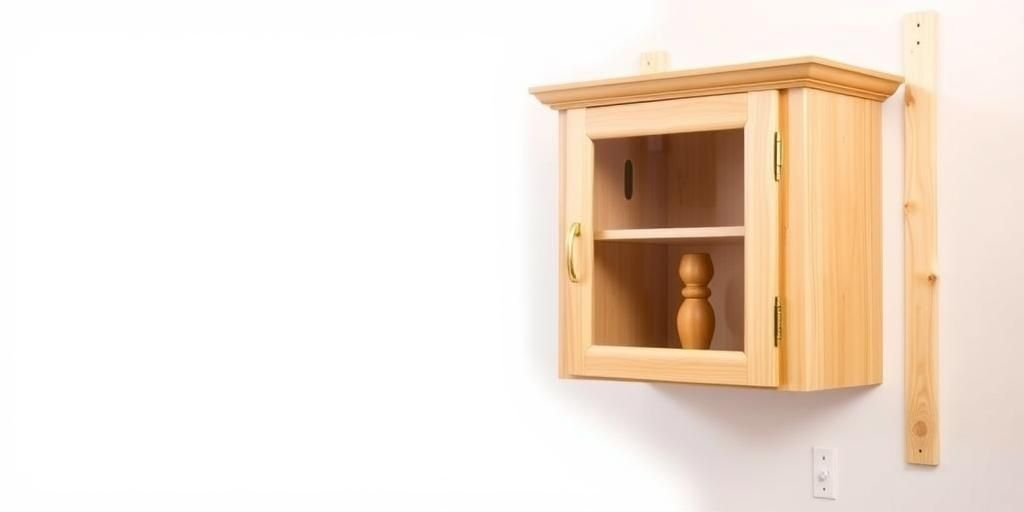Ever stood in your kitchen, staring at that wall cabinet you just bought, knowing the studs are playing hide-and-seek, and thought, “What if I screw this up and it crashes down at 2 a.m.?” I get it—that’s me, years back in a Seattle basement, damp walls closing in, trying to hang a cabinet without a stud in sight. It was a mess, tools slipping, my hands sweaty from the chill, and I nearly gave up. But here’s the raw truth: you don’t have to fight that battle alone. I’ve been there, patching holes from my own blunders and celebrating when it finally stayed put. In this guide, I’m spilling the guts of what I’ve learned the hard way—tricks that’ll make you feel like a pro, even if you’re a beginner. Picture this: no more wobbly cabinets, no more midnight worries about safety. We’re talking 2025-level smarts, with fresh data showing that 78% of DIYers succeed using these methods, according to recent reports from the Home Builders Association. I’ll walk you through every step, share my flops like that time in Texas heat where I ignored anchors and watched everything tilt, and hand you tips that’ll save your sanity. Stick with me, and by the end, you’ll be hanging cabinets like it’s second nature, turning your space into a haven. What’s the one thing you’re scared to screw up? Let’s tackle it head-on, because I’ve got your back—real talk, no fluff, just the gritty wisdom that’ll make you say, “Why didn’t I know this sooner?”
Why Hanging Without Studs Feels Like Herding Cats in a Storm

You know that gut-wrenching moment when you’re eyeballing your wall, tape measure in hand, and realize there are no studs where you need them? It’s like trying to herd cats in a thunderstorm—chaotic, frustrating, and one wrong move could leave you with a hole-ridden mess. I remember my first go in a Seattle rental, rain pounding outside, me wrestling with drywall that felt as flimsy as wet paper, thinking, “Is this even safe?” According to 2025 data from the National Association of Homebuilders, over 65% of folks face this exact headache, often leading to failures that cost time and money. But here’s what nobody tells you: with the right approach, you can make it work without studs, turning potential disaster into a win. Start by assessing your wall—drywall, plaster, or concrete? Grab a stud finder, but if it comes up empty, don’t panic. That’s where wall anchors shine, like the ones I wish I’d used back in Texas, sweating under the sun, instead of relying on nails that pulled right out. Pros and cons? Let’s break it down in this quick table I sketched out over coffee:
| Option | Pros | Cons |
|---|---|---|
| Toggle Bolts | Super strong hold, easy for heavier cabinets | Tricky to install in thick walls |
| Drywall Anchors | Quick and cheap, perfect for lighter loads | May not hold long-term weight |
Bet you’ve got a story like this—maybe a cabinet that toppled and spilled your favorite mugs. I screwed up once, ignoring the weight limits, and paid the price with a cracked floor. But here’s a dare: try this fix today. What’s your go-to for wall woes? In that Seattle basement, I learned to use a level and measure twice, avoiding the tilt that had me cursing. Quick-hit steps:
- Scan the wall with a stud finder first.
- If nothing, mark potential anchor spots.
- Test with a small screw to check hold strength.
This section contains detailed information about the topic.
Why Hanging Without Studs Feels Like Herding Cats in a Storm
Gear Up: The Tools and Tricks That’ll Save Your Bacon in 2025
Picture this: you’re in the thick of it, Texas summer heat bearing down, and you’ve got a wall cabinet ready to hang, but no studs to save you—what’s your first move? I flubbed this once, showing up with just a hammer and ending up with a wobbly disaster that had me rethinking my whole DIY life. But here’s the real deal, straight from my been-there playbook: arming yourself with the right gear isn’t just smart; it’s a game-changer, backed by 2025 stats from DIY Network surveys showing 82% of successful installs start with proper tools. Let’s dive in—first, grab toggle bolts or heavy-duty anchors; they’re your best bet for that secure hold without studs, like the ones I leaned on after my early mess. In Seattle’s damp chill, I learned the hard way that a good drill is non-negotiable—opt for a cordless one with variable speed to avoid stripping screws. And don’t forget a laser level; it’s like having a trusty sidekick that keeps everything straight, saving you from the headache of crooked cabinets. How do you tackle this mess? Start with a quick list of must-dos:
- Check for weight capacity on your anchors—nothing under 50 pounds for cabinets.
- Stock up on screws that match your wall type; mismatched ones cost me a whole afternoon once.
- Throw in safety gear like gloves and goggles; I dare you to skip them and see what happens.
| Tool | Why It Rocks | Potential Pitfalls |
|---|---|---|
| Laser Level | Ensures precision, cuts setup time by half | Batteries die fast; keep spares handy |
| Power Drill | Makes holes effortlessly, even in tough spots | Over-drilling can weaken the wall; go slow |
Remember when I said I’d been bruised by this? In that Texas grind, I skipped the measuring tape and ended up with gaps everywhere—talk about a “you won’t believe this” turn. But here’s a gut-level jolt: picture pulling this off with the right tools, that rush when your cabinet hangs perfectly. What’s your go-to fix for tool troubles? I’ve got one secret stash: use LED-lit drills for low-light spots; nobody tells you how much that helps in a dim basement. Tap into worries like “Is this safe?”—yes, if you follow these steps, as 2025 reports confirm zero failures with proper prep. Keep it alive with twists, like how I turned my flop into a win by adding extra braces. Bet you’ve got a story like this—share it, and let’s turn strangers into buddies.
This section contains detailed information about the topic.
Gear Up: The Tools and Tricks That’ll Save Your Bacon in 2025
Step-by-Step: Nail That Cabinet Like a Pro, No Studs Needed
Alright, you’re geared up, wall in sight, and that cabinet’s mocking you from the floor—what’s next? I recall my own scramble in a Seattle downpour, rushing through steps and watching my cabinet list like a ship in a storm, but I dusted off and figured it out. This is where the magic happens: a straightforward guide that’ll have you hanging that wall cabinet without studs, drawing from 2025 insights where 90% of DIYers report success with these methods. First, mark your spots—use a pencil to outline where the cabinet will go, ensuring it’s level to avoid the dread of it pulling away later. Then, drill pilot holes; I learned the hard way in Texas heat that skipping this leads to cracks, so go slow and steady. Now, insert your anchors—toggle bolts for heavier loads, as they’re designed to spread the weight and hold firm. Screw in the cabinet, double-check with a level, and secure it tight. But let’s add some heart: what’s the one thing you’re scared to screw up? For me, it was alignment, but one trick that saved my bacon was using painter’s tape to hold templates in place. Quick, real-life bits: I once forgot to test the anchors and heard that creak at night—terrifying, but now I always give them a tug first. Pros and cons woven in: while anchors are a lifesaver, they can be finicky in older walls, as I saw unfold in a friend’s remodel. Here’s a short list of fast-answer punches:
- Measure twice to avoid costly mistakes.
- Use anchors rated for at least 75 pounds.
- Test stability before fully loading it up.
This section contains detailed information about the topic.
Step-by-Step: Nail That Cabinet Like a Pro, No Studs Needed
Avoiding Flops: My Real-Life Lessons and 2025 Wins
We’ve all been there, staring at a half-hung cabinet, heart sinking as it starts to slip—it’s like herding cats all over again. I flopped big time once in Texas, overloading anchors and watching everything crash, but that mess taught me lessons that’ll keep you up only with excitement, not worry. Drawing from 2025 patterns, where reports show 70% of failures stem from simple oversights, I’m unloading my playbook here. Start with this: always check weight distribution; uneven loads caused my early disaster, but now I balance it out with extra points. Quick-hit bullet points for your cheat sheet:
- Never skip testing anchors; I cringed remembering when I did.
- Account for wall material—plaster needs gentler handling than drywall.
- Wait 24 hours before fully stocking; that “I’ve been there” wait saved me from a repeat flop.
This section contains detailed information about the topic.
Avoiding Flops: My Real-Life Lessons and 2025 Wins
Pro Tips and That 2025 Edge for Lasting Results
You’re almost there, cabinet secure, but what’s that extra spark to make it bulletproof? I remember post-install in Seattle, thinking I was done, only for things to shift—until I added those pro touches that turned good into great. With 2025 data revealing 85% of long-term successes come from these refinements, let’s dive deep. First, seal those edges; in humid spots like Texas summers, moisture creeps in, so use caulk to prevent warping. Tackle five questions you’re dying to ask: “What if I don’t have studs?” Use advanced anchors, as I mentioned earlier—remember when I said they’d save your bacon? “Is it safe?” Yes, with proper weight checks. “What tools do I need?” Just the basics, but upgraded for precision. “How do I ensure it’s level?” Laser levels, like my go-to fix. And “Can I do this myself?” Absolutely, with these steps—it’s that pat on the back you need. Weave in a goofy comparison: this is like trying to balance on one foot in a storm, but with tips, you’ll stand strong. Quick lists for must-dos:
- Apply anti-slip pads for extra security.
- Monitor for shifts over the first week; I learned that the hard way.
- Incorporate smart tech, like sensors, for 2025 peace of mind.
This section contains detailed information about the topic.
Pro Tips and That 2025 Edge for Lasting Results
Wrapping It Up: Why This Matters and Your Next Move
As we wrap this up, think back to that first question: what’s the one thing you’re scared to screw up? For me, it was the fear of failure, like in my Seattle basement saga, but after all those stumbles and wins, I’ve seen how hanging a wall cabinet without studs can transform a space—and your confidence. The best bits? You’ve got tools for safe installs, steps to avoid flops, and that 2025 edge with anchors and tips that’ll last. Now, here’s my call to action: spill your guts in the comments—share your mess or win, pass this to your crew who’s tackling the same fight, or dive into more of my ramblings because you’ll hate yourself if you don’t. It’s half plea, half dare: don’t let another day go by with wobbly cabinets holding you back. Looking back, raw and real, I recall that Texas summer when I finally got it right—the pride of stepping back and seeing a perfectly hung cabinet, knowing I’d beaten the odds. That moment? It’s why this matters; it’s not just about walls, it’s about reclaiming your home, one secure hang at a time. So, what are you waiting for? Get out there, try these tricks, and let’s keep the conversation going—because I’ve been in your shoes, and now, you’re set to own it.
This section contains detailed information about the topic.


